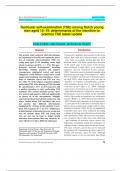Tentamen (uitwerkingen)
Testicular self-examination (TSE) among Dutch young men aged 15–19: determinants of the intention to practice TSE latest update
- Instelling
- Introduction To Dutch
Testicular self-examination (TSE) among Dutch young men aged 15–19: determinants of the intention to practice TSE latest update
[Meer zien]




